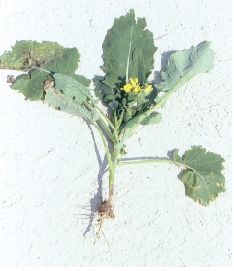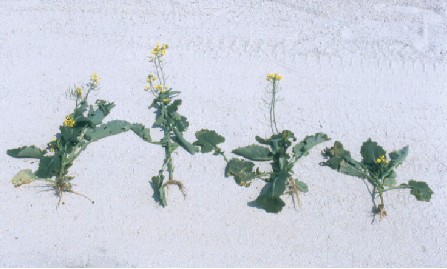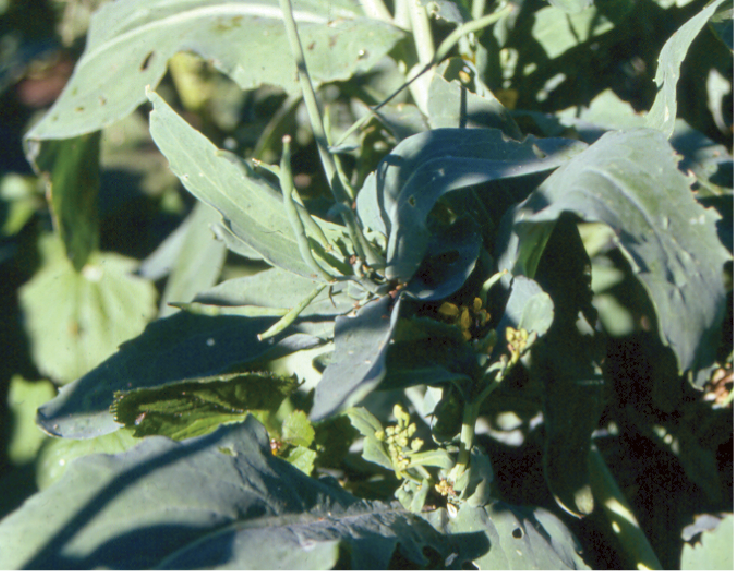
News
New canola pest found on the Prairies
Canola growers can add another insect to their crop scouting list. Swede midge, an insect that feeds on cruciferous crops, has been detected on the Canadian Prairies. This tiny insect has the potential to affect yields if it attacks canola plants at a vulnerable growth stage.
April 30, 2010 By Carolyn King

|
|
| If swede midge attacks canola before bolting, the meristem may die. Photo courtesy of Dr. Rebecca Hallett, University of Guelph. | |
 |
|
| Another symptom of swede midge: a stunted stem with few flowers. Photos courtesy of Dr. Rebecca Hallett, University of Guelph. | |
 |
|
| Effects of the swede midge attacks on canola from early in the plant’s development to later stages (from right to left). | |
 |
|
| Swede midge larvae feed on the canola plant’s young, developing tissue, causing shortened stems, crumpled leaves and other distortions. Photo courtesy of James Heal.
|
Canola growers can add another insect to their crop scouting list. Swede midge, an insect that feeds on cruciferous crops, has been detected on the Canadian Prairies. This tiny insect has the potential to affect yields if it attacks canola plants at a vulnerable growth stage.
Swede midge is native to Europe and Asia. Its first identified occurrence in North America was in Ontario in 2000, although it has likely been in that province since at least 1996. The midge has been identified in five other Canadian provinces (Quebec, Nova Scotia, Prince Edward Island, Manitoba and Saskatchewan) and in the United States.
So far, only a very few swede midge have been detected in the Prairie provinces (see sidebar). However its prairie population will likely grow. “Now that the swede midge is in the Prairies, I expect that it’s going to continue to spread and pop up in different areas,” says Dr. Rebecca Hallett, an entomologist at the University of Guelph. Hallett and her research team have been studying swede midge and assessing its impact on canola production in the Prairies and Ontario.
“We have determined through bioclimatic modelling that the swede midge will be able to establish and have high population growth in the Prairies. In moist years population growth will be higher, but in dry years the population won’t increase as rapidly,” she notes. “We have done modelling as well using different scenarios of climate change. All of the combinations that we have looked at indicate that the swede midge will increase in its range and the population growth potential will increase with future climate change.”
The models show its range will extend throughout the prairie provinces, except for their most northerly areas. Its range and population size will be almost entirely determined by moisture conditions.
More research is needed to determine exactly how the timing of the insect’s life cycle under Prairie conditions might line up with the timing of canola crop development. That timing is crucial because if midge numbers are already high before the plants have bolted, then impact on yields could be severe. “Years when growers seed canola early, a lot of our canola may be beyond the bud stage before swede midge would build its population up,” says Dr. John Gavloski, entomologist with Manitoba Agriculture, Food and Rural Initiatives. “But there may be years with late seeding where swede midge could be an issue. So far it hasn’t been. The reason might be because the levels of swede midge right now are so low that any little bits of damage are going unnoticed, or because the timing hasn’t been just right. We really don’t know right now.”
Scott Hartley, provincial insect/pest management specialist with Saskatchewan Agriculture, says swede midge has the potential to be a serious problem in Saskatchewan. “Its hosts are all crucifer vegetable crops and canola, which is one of the biggest crops in Saskatchewan, so there are a lot of hosts for it here. Under favourable climatic conditions, it could have a very serious effect on production. But at this point it is really hard to predict how bad it might be.”
Severity depends on timing
Swede midge overwinters in the soil and emerges as an adult in the spring. “It lays its eggs on young, developing tissue, and so whenever there is young, developing tissue present, the plant is susceptible to infestation,” says Hallett.
The larvae hatch from the eggs and feed on the developing tissue for up to two weeks. Then they drop to the soil to pupate, and in a couple of weeks, the next generation of adults emerges. The insect has multiple generations in a year, with the number of generations depending on the climate.
The damage to plants is caused by the larvae. Gavloski says, “The larvae essentially salivate on to the leaf or the stem or the bud or whatever they are on, and their saliva softens up the area, turning it into a liquid. Then they ingest that liquid. The plant changes physiologically in the area where they have fed. As a result you get distorted, scarred, puffy or bloated tissue. So you might see distorted, crinkled leaves, or buds that are distorted or puffy and don’t emerge as flowers and pods later on. Sometimes you get multiple branching on the plant if they have damaged a meristem, a growing point.”
Tracking swede midge The Canadian Food Inspection Agency (CFIA) started monitoring for swede midge in 2002, when the agency declared this insect to be a regulated quarantine pest. The regulations impacted on the movement of cole crop transplants going from areas in Ontario and Quebec, where swede midge had been found, to other parts of Canada. The regulations did not directly affect the canola industry. The CFIA’s Doug Winmill says, “Whenever we consulted with industry on swede midge during the years it was regulated, we tried to emphasize that canola seed and grain were not pathways that would or could potentially move the insect from one area to another. We also emphasized that detections of swede midge in Western Canada would not jeopardize any of Canada’s canola export markets.” Initially monitoring was by visual inspection. The CFIA switched to swede midge pheromone traps when the traps became available in 2005; those traps increased detections. In the Prairie provinces, the CFIA monitored for the insect from 2006 to 2008. The insect was detected in Saskatchewan at three sites in 2007 and at two sites in 2008. It was detected in Manitoba at two sites in 2008. It was not found in Alberta traps during those three years. The CFIA ceased monitoring for swede midge after 2008 because Canada and the US agreed that it was no longer necessary to have quarantine regulations for swede midge. That decision was taken for several reasons, in part because the insect had spread to many areas, despite appropriate quarantine steps, and because options to control swede midge are now available. At present there is only limited monitoring for the pest on the Prairies because its population numbers are so low. Entomologist Dr. Juliana Soroka with Agriculture and Agri-Food Canada says, “I monitored for swede midge using pheromone traps at two sites in Saskatchewan during the summer of 2009, and did not identify it. One of my sites was close to a site where it was found by the CFIA in 2007, and the absence in 2009 indicates that populations of the insect must be very low.” |
||||
The exact symptoms depend on where the larvae are feeding and how concentrated that feeding is.
The effect on canola yields depends on the crop’s stage at the time of attack. “When canola is hit in its early stages, the impact can be devastating,” notes Hallett. “In Ontario, the places where damage has been really quite severe are in late-planted fields. I have seen entire fields that are just unharvestable, with very, very few pods.”
She says, “If canola plants are infested by swede midge when they are in the vegetative stages, you see crumpling and twisting of the leaves, possible death of the meristem, and swelling of the leaf petioles. If the meristem survives, typically it is unable to bolt completely so you have a short, stunted inflorescence with few flowers on it. That is the most vulnerable stage for swede midge to hit canola. “After that initial bolting, you see damage to the secondary racemes as they are developing in the leaf axils. And often you’ll get small, stunted clusters of buds that are brown and twisted up. The brown is because secondary rots get in after the swede midge has been feeding there,” says Hallett.
One of the most distinctive symptoms is the bouquet effect, which occurs if the midge attacks after the plant has bolted and set up its flowers. “Their feeding stunts the elongation of the bolt, but you still get some pod formation. However, the pods tend to be clustered together around the damaged point at the top of the stem,” says Derwyn Hammond, a Manitoba-based agronomy specialist with the Canola Council of Canada. If the plant is hit at that point, the damage to yields is usually reduced since those clustered pods can still produce some seed.
After full flowering, swede midge attacks do not impact canola yield.
Scouting for swede midge
“Anytime you see a new pest, there is potential that over time it may increase to become a significant pest. At this time the best advice is to scout in the field and watch for any bulletins,” says Hammond. “If swede midge symptoms start to show up in fields, then all the extension agencies, including ourselves, would be keeping growers apprised of that. If it emerges as a serious pest then we’ll look at offering advice on control options.”
The adult flies are not very noticeable. Gavloski says, “They are a very small, fragile fly and they tend to stay fairly low within the canopy or just above the canopy.”
Hallett advises, “The first place to look for swede midge is in sheltered areas. The adult fly gets blown in from some distance away, and typically settles down in less windy areas, and then spreads across the field from there.”
Growers should check for symptoms like crinkled leaves, swelling, distortions, stunted stems, multiple branches, distorted buds that do not turn into flowers and pods, and bouquets of bunched-up pods.
However, Hammond reminds growers that similar symptoms can be caused by other problems, like damage from herbicides, frost or other insects. For instance, he says, “A Group 2 herbicide injury will often produce similar symptoms because those chemistries attack the growing point. So scouts need to watch for that and be clear about what they are looking for.” He notes the Canola Council has a very good guide to herbicide injury symptoms available from its website or its head office.
“You really need to see the larvae on the plant as well as the distorted tissue for more solid evidence that swede midge is the cause of the damage. The larva is about three to four millimetres (roughly a sixth of an inch) long and it can either be white or yellowish. It looks like a little rice grain,” advises Gavloski. “I would encourage anyone who finds that type of damage to take a sample, put it in a bag, send it to either their provincial entomologist or a farm production advisor who could pass it on.”
That information will help entomologists to track the insect’s progress, assess its degree of threat and be better able to advise growers if control steps are needed.
Hallett concludes, “Swede midge will cause severe damage under particular conditions and it’s likely to be a constant presence in the Prairies. So it will be something that growers will always have to keep in mind. The severity of the damage will depend greatly on how moist a particular season is and how early they plant.”